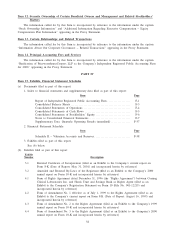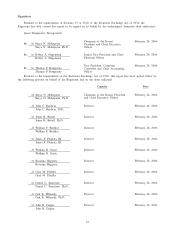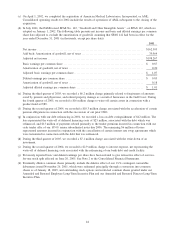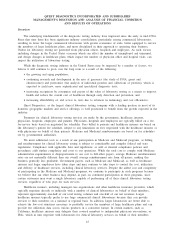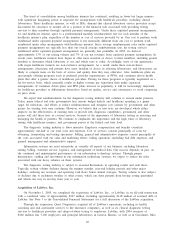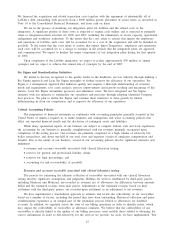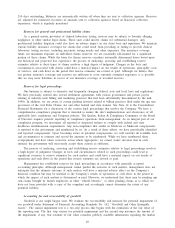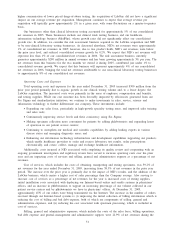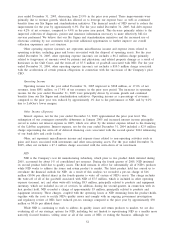Quest Diagnostics 2005 Annual Report Download - page 63
Download and view the complete annual report
Please find page 63 of the 2005 Quest Diagnostics annual report below. You can navigate through the pages in the report by either clicking on the pages listed below, or by using the keyword search tool below to find specific information within the annual report.The trend of consolidation among healthcare insurers has continued, resulting in fewer but larger insurers
with significant bargaining power to negotiate fee arrangements with healthcare providers, including clinical
laboratories. These healthcare insurers, as well as IPAs, demand that clinical laboratory service providers accept
discounted fee structures or assume all or a portion of the financial risk associated with providing testing
services to their members through capitated payment arrangements. Under these capitated payment arrangements,
we and healthcare insurers agree to a predetermined monthly reimbursement rate for each member of the
healthcare insurer’s plan, regardless of the number or cost of services provided by us. Our cost to perform work
reimbursed under capitated payment arrangements is not materially different from our cost to perform work
reimbursed under other arrangements with healthcare insurers. Since average reimbursement rates under capitated
payment arrangements are typically less than our overall average reimbursement rate, the testing services
reimbursed under capitated payment arrangements are generally less profitable. In 2005, we derived
approximately 17% of our testing volume and 7% of our net revenues from capitated payment arrangements. In
recent years, healthcare insurers have begun to offer more freedom of choice to their members, including greater
freedom to determine which laboratory to use and which tests to order. Accordingly, most of our agreements
with major healthcare insurers are non-exclusive arrangements. As a result, under these non-exclusive
arrangements, physicians and patients have more freedom of choice in selecting laboratories, and laboratories are
likely to compete more on the basis of service and quality than they may otherwise. Also, healthcare plans are
increasingly offering programs such as preferred provider organizations, or PPOs, and consumer driven health
plans that offer a greater choice of healthcare providers. Pricing for these programs is typically negotiated on a
fee-for-service basis, which generally results in higher revenue per requisition than under capitation
arrangements. If consumer driven plans and PPO plans increase in popularity, it will be increasingly important
for healthcare providers to differentiate themselves based on quality, service and convenience to avoid competing
on price alone.
We expect that reimbursements for the diagnostic testing industry will continue to remain under pressure.
Today, many federal and state governments face serious budget deficits and healthcare spending is a prime
target for reductions, and efforts to reduce reimbursements and stringent cost controls by government and other
payers for existing tests may continue. However, we believe that as new tests are developed which either
improve on the effectiveness of existing tests or provide new diagnostic capabilities, government and other
payers will add these tests as covered services, because of the importance of laboratory testing in assessing and
managing the health of patients. We continue to emphasize the importance and the high value of laboratory
testing with healthcare insurers, and government payers at the federal and state level.
The diagnostic testing industry is labor intensive. Employee compensation and benefits constitute
approximately one-half of our total costs and expenses. Cost of services consists principally of costs for
obtaining, transporting and testing specimens. Selling, general and administrative expenses consist principally of
the costs associated with our sales and marketing efforts, billing operations (including bad debt expense), and
general management and administrative support.
Information systems are used extensively in virtually all aspects of our business, including laboratory
testing, billing, customer service, logistics, and management of medical data. Our success depends, in part, on
the continued and uninterrupted performance of our information technology systems. Through proper
maintenance, staffing and investment in our information technology systems, we expect to reduce the risks
associated with our heavy reliance on these systems.
The diagnostic testing industry is subject to seasonal fluctuations in operating results and cash flows.
Typically, testing volume declines during the summer months, year-end holiday periods and other major
holidays, reducing net revenues and operating cash flows below annual averages. Testing volume is also subject
to declines due to inclement weather or other events, which can deter patients from having testing performed
and which can vary in severity from year to year.
Acquisition of LabOne, Inc.
On November 1, 2005, we completed the acquisition of LabOne, Inc., or LabOne, in an all-cash transaction
with a combined value of approximately $947 million, including approximately $138 million of assumed debt of
LabOne. See Note 3 to the Consolidated Financial Statements for a full discussion of the LabOne acquisition.
Through the acquisition, Quest Diagnostics acquired all of LabOne’s operations, including its health
screening and risk assessment services to life insurance companies, as well as its clinical diagnostic testing
services to healthcare providers and drugs-of-abuse testing to employers. LabOne, with 2004 revenues of
$468 million, has 3,100 employees and principal laboratories in Lenexa, Kansas, as well as in Cincinnati, Ohio.
46




